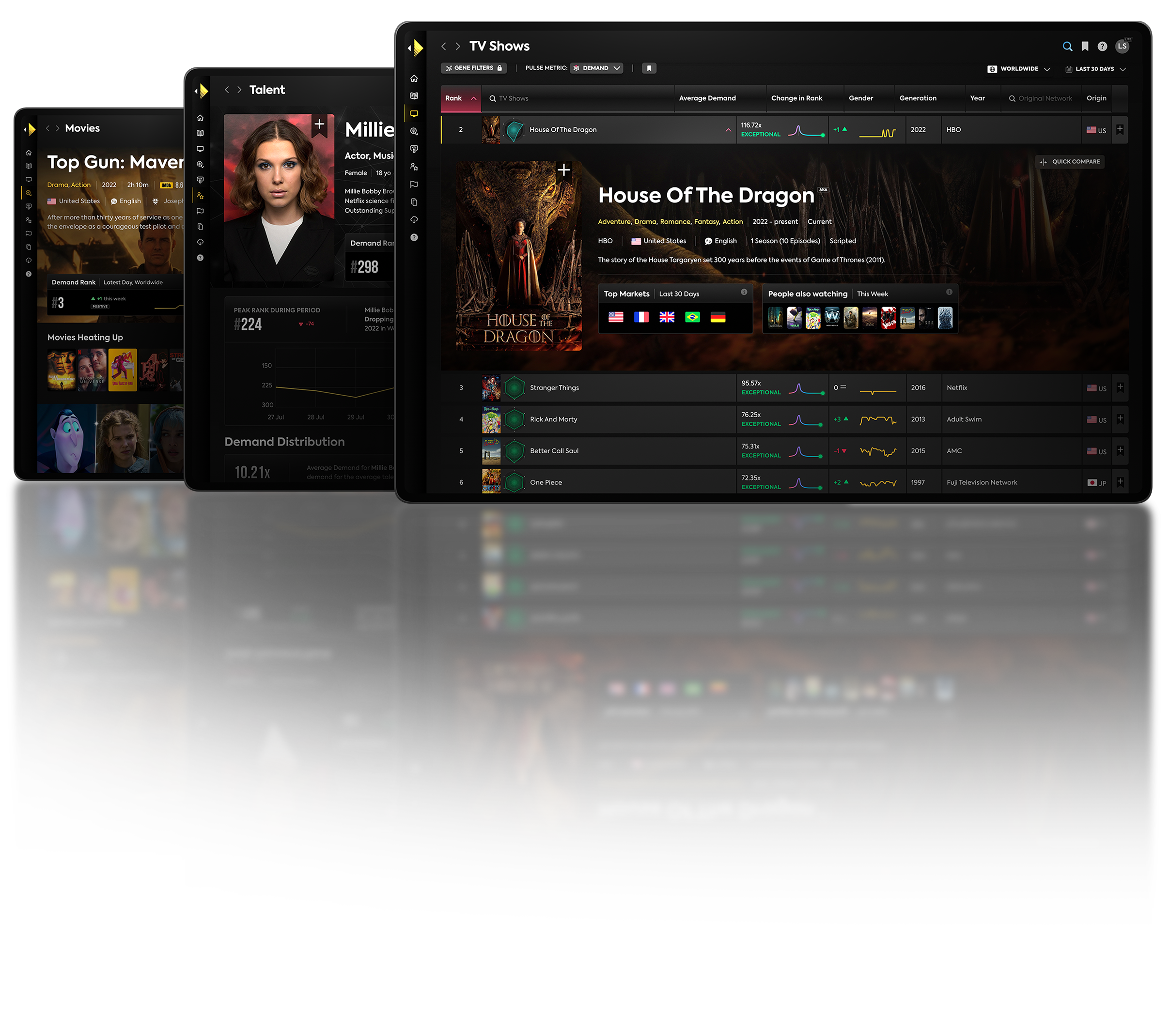In this last chapter of the 30,000 Foot View: A Preview of The 2020 Streaming Wars, Parrot Analytics’ series deep-diving into the factors governing success at the dawn of the streaming wars, we reveal the key strategies for creating SVOD-defining, blockbuster originals that all the new streamers will need.
Transforming the niche to mainstream
Thus far, we have evidenced the theory that digital originals, defined as content that premiers on a streaming platform, are central to a platform’s success. Specifically, we find digital originals generate exclusive demand for platforms and drive subscriber growth.
This original content is unique and niche, often well-suited for novel viewing patterns (i.e., binging). These attributes explain why demand gained from originals is critical.
Take, for instance, Stranger Things – a show which Netflix has recently leaned on to increase its subscriber numbers in Q3 2019 after the platform missed its subscriber expectations in Q2. Before its release, Daniel D’Addario stated the show was designed for audiences with a specific nostalgia for the Goonies-era cinema, and yet was a wildly new form of storytelling. Because of hindsight, it may be difficult to believe that Stranger Things would not be a success if released weekly or on a linear channel first. Perhaps, a cable channel should have supported it, but it is unlikely it would be the global success it is today without Netflix’s global reach. Stranger Things is just one example, which reflects a larger trend that began with House of Cards for Netflix.
On other platforms, the success of The Handmaid’s Tale for Hulu, which made TV history by transforming niche content into a mainstream hit, was similarly responsible for increased subscriptions. And it is perhaps fair to say that The Marvelous Mrs. Maisel is Amazon Prime Video’s flagship original, next to The Man in the High Castle. The value of mainstreaming niche content via original productions is undeniably key to SVOD success.
DC Universe’s SVOD platform also exemplifies the success of unique original content. As a platform that purely caters to superhero content, DC Universe has garnered great demand and has quickly caught up to competitors in its short lifespan. This is not to say that this content, which is also high-quality (based on its title average demand), would not succeed elsewhere as seen on the CW or in movies. Rather, its rapid growth in capturing high demand for a specialized subgenre and target audience is commendable. And, it appears DCU will continue to pursue unique originals in this niche, by exploring unscripted and mixed-media anthologies.
The charts below highlight the platform’s US success in the action/adventure audience segment (Note: share of digital originals only).
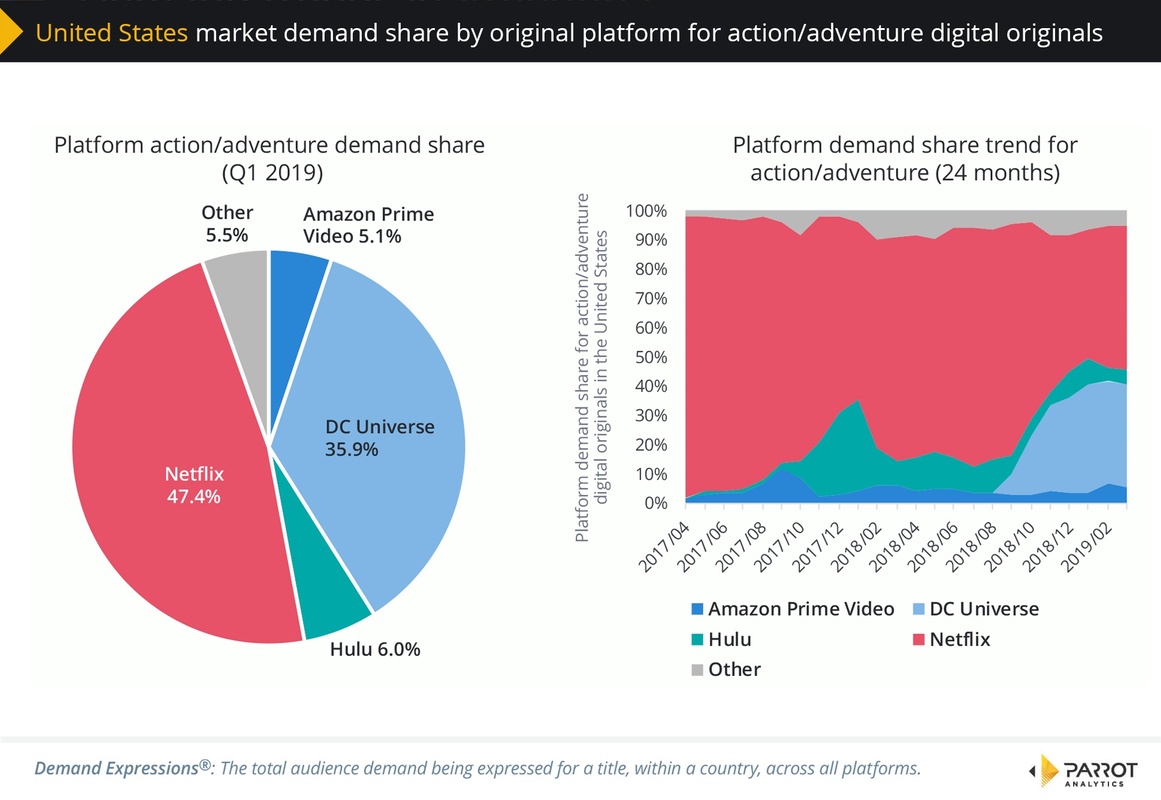
Originals create important buzz with audiences and they are a necessary source of value that draws in new subscribers. They solve problems by providing niche audiences the content they wish they had and by promising mainstream audiences novelty. But how can entertainment-hungry audience segments be satisfied with originals that are unique and worthy of their attention? The major streaming platforms are armed with originals for the battle, let us find out what it takes to be victorious.
Hit originals are powered by analytics
For the last six years, Netflix has been outspoken about the ways the company has leveraged data to successfully create blockbuster originals, which undoubtedly led them to achieve their status as a streaming giant. As newcomers such as Apple TV+ invest the likes of $6bn on original content, the new contenders are no doubt hoping their originals will have a similar ROI.
Parrot Analytics has been observing the existing and growing competition in the SVOD space for many years now: As the only company with a truly global “30,000-foot view” across all TV series in near-all markets, we can confidently say that the strategic uses of data and analytics are what fuel digital original hits.
Today, we are pleased to share with our readers the insights required to discover where the opportunity lies for new originals and how to stand out in a crowded and global content ecosystem.
White spaces: Where the opportunity lies
“White spaces” represent potential opportunities in a market. Our findings reveal that these can occur when audience desire for content exceeds the supply of titles for that content. We refer to this phenomenon as “undersaturated”.
Parrot Analytics uses content genes such as genre, theme, mood, release type, subgenre and many more to identify white spaces. By combining these genes we can take an increasingly granular approach to identify white space content opportunities to activate niche audiences.
To serve as a macro-level example, this article will now explore genre category white spaces, which are revealed by examining the demand all titles in a genre drive, compared to the number of titles populating that genre.
The chart below visualizes the genre white spaces, which we refer to as “undersaturated”, and also shows where a genre is oversaturated, across all platforms in the United States:

Reality shows especially, in addition to documentaries, factual shows, variety shows, and horror shows represent oversaturated genres in the US on the bases of our definition. In relative terms, this means the number of titles in the genre exceeds the total market demand (which is also why these genres are below the trend line in the chart). It follows that the further any genre gets from the trend line, the bigger the size of the opportunity that exists in the market for that genre.
Here are some additional observations we can make:
- Over the last 12 months, dramas and comedies have owned the greatest demand share in the US, as is represented by their placement on the y-axis on the chart above. These two genres attract the greatest total market demand.
- Drama, children’s content, animation and action-adventure, can be found to the left of the dotted line and are potential white spaces.
- Comedies are almost perfectly at equilibrium with little apparent room for more growth. Although comedies represent a smaller opportunity, they are highly in-demand. A new comedy title can draw in audiences, and because audience attention is finite it can take away demand from an existing comedy title.
For new SVODs, an undersaturated and highly in-demand genre is likely to cross taste clusters (i.e., representing the preferences of mainstream audiences) and therefore it can drive subscribers. Thus, we can rank each of the genres using demand and the size of opportunity (white space). In our rankings, drama is an exceptional genre with the highest total demand and yet a sizable amount of white space exists as demonstrated by its distance from the trend line in the chart above.
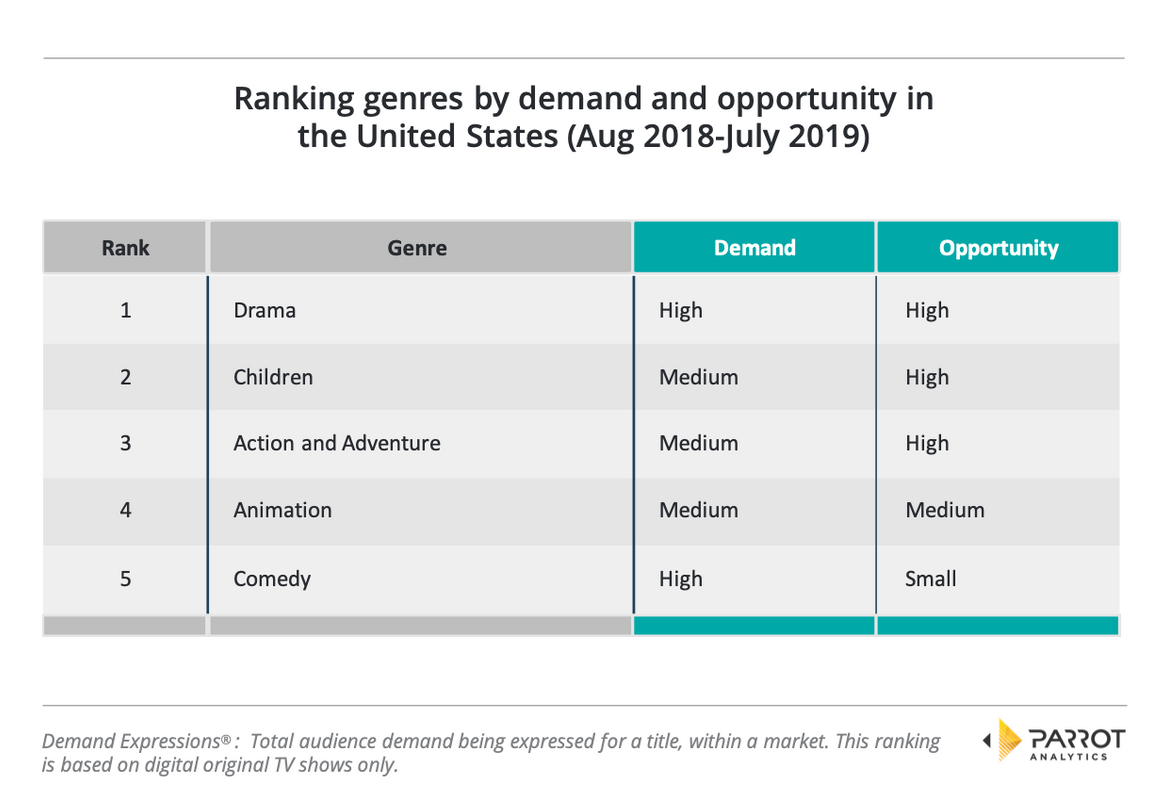
These rankings may be good news for streamers such as Disney+, Apple TV+, and AT&T’s HBOMax, which have ownership of in-demand children’s content such as Mickey Mouse and Sesame Street. Children’s content may be especially valuable for new streamers that need to attract and retain subscribers because, as Kelsey Sutton of AdWeek points out, children are “relatively churnproof”.
Standing out in the crowded content ecosystem
Yet, opportunities are not all equally accessible. Within the content genome, the distribution of demand among titles can vary; some genres, for instance, experience the long tail of content. When a “long tail” is present, the amalgamation of titles with this genetic make-up are skewed towards lower demand. There is a greater proportion of low-demand titles and a smaller proportion of high-demand titles.
Thus, after identifying where the opportunities lie within the content genome, it is necessary to examine the existing competing titles. When long tails of content are found in white spaces, the opportunity is often coupled with a lot of clutter, which may drive audiences to desire a more high quality title.
To gain insights into the distribution of demand, we can continue within our macro-level example by comparing the difference between the average demand per title and the total demand of each genre. While some genres may overall receive more demand as digital originals, their titles may not be as high quality on average.
On the chart below, digital original genres that are higher on the y-axis include more high quality titles, those further out on the x-axis are highly in-demand, and the size of the bubble represents the number of titles driving demand.

While drama is a highly in-demand white space, it is coupled with a long-tail of content – a greater proportion of existing content is not perceived as high-quality by audiences. Thus, its title average demand is much lower, in relative terms, than its total demand. But the demand driven by digital original dramas is so large that despite the long-tail there is still room for more titles that can capture this demand. However, one must remember that this is a highly competitive genre where successful and desirable titles must be of truly high-quality to stand out and capture share.
The action and adventure genre, on the other hand, is a white space genre demonstrating the exact opposite pattern. While the genre owns a smaller sliver of total demand for digital originals in the US, on average, each title receives a much greater share of the total demand expressed for this genre. SVOD players that recognize and capitalize on this fact will create a strategic advantage for themselves.
The action and adventure genre is therefore not only a white space with high demand, but also one where the average title is considered more high-quality. Currently, the genre may be perceived as high quality in general, leaving space for more moderate to low quality shows to potentially benefit as well.
Therefore, the rank order of genres that a new streamer is advised to pursue changes when the factor of the long tail of content is incorporated; we therefore update our earlier table and present the new table below:
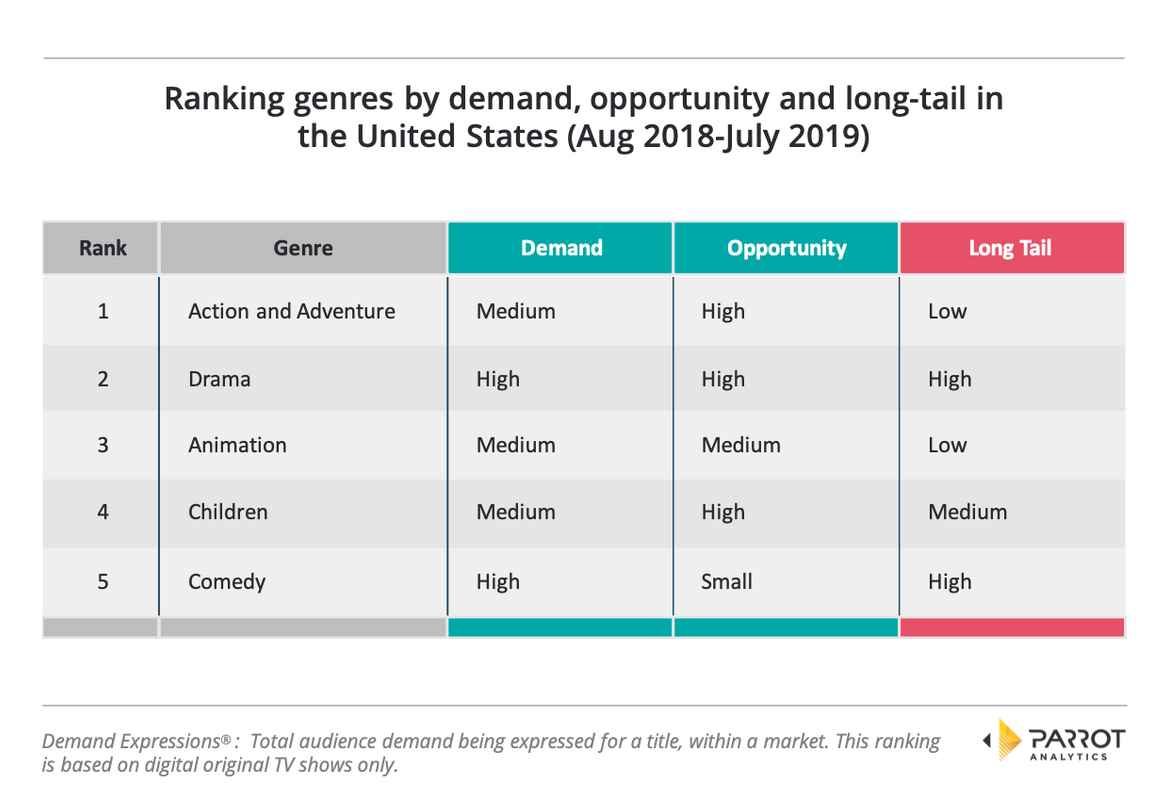
We can conclude nonetheless that dramas and action and adventure are perhaps the most desirable genres for exactly polar opposite reasoning and at this point other factors may weigh in on decision-making: For instance, in the streaming wars there is an especially powerful factor that must be considered, which is intellectual property (IP).
But, is it best to leverage IP in oversaturated or undersaturated genres? If it is best to leverage their power in white spaces, should Disney, WarnerMedia, and NBCU aim to expend their IP to help content stand out against the long-tail? In this next section we will examine this question in greater detail.
Leveraging intellectual property to drive demand
Because known IP often has already proven its ability to obtain demand from audiences in previous content, risk is de-escalated. It is therefore no surprise that Disney and WarnerMedia, which own a great deal of well-known IP, will be leveraging these jewels in their originals. In fact, our data suggests this is well-advised, because we can demonstrate that leveraging known IP increases demand for titles across genres. The following chart is clear in this respect.
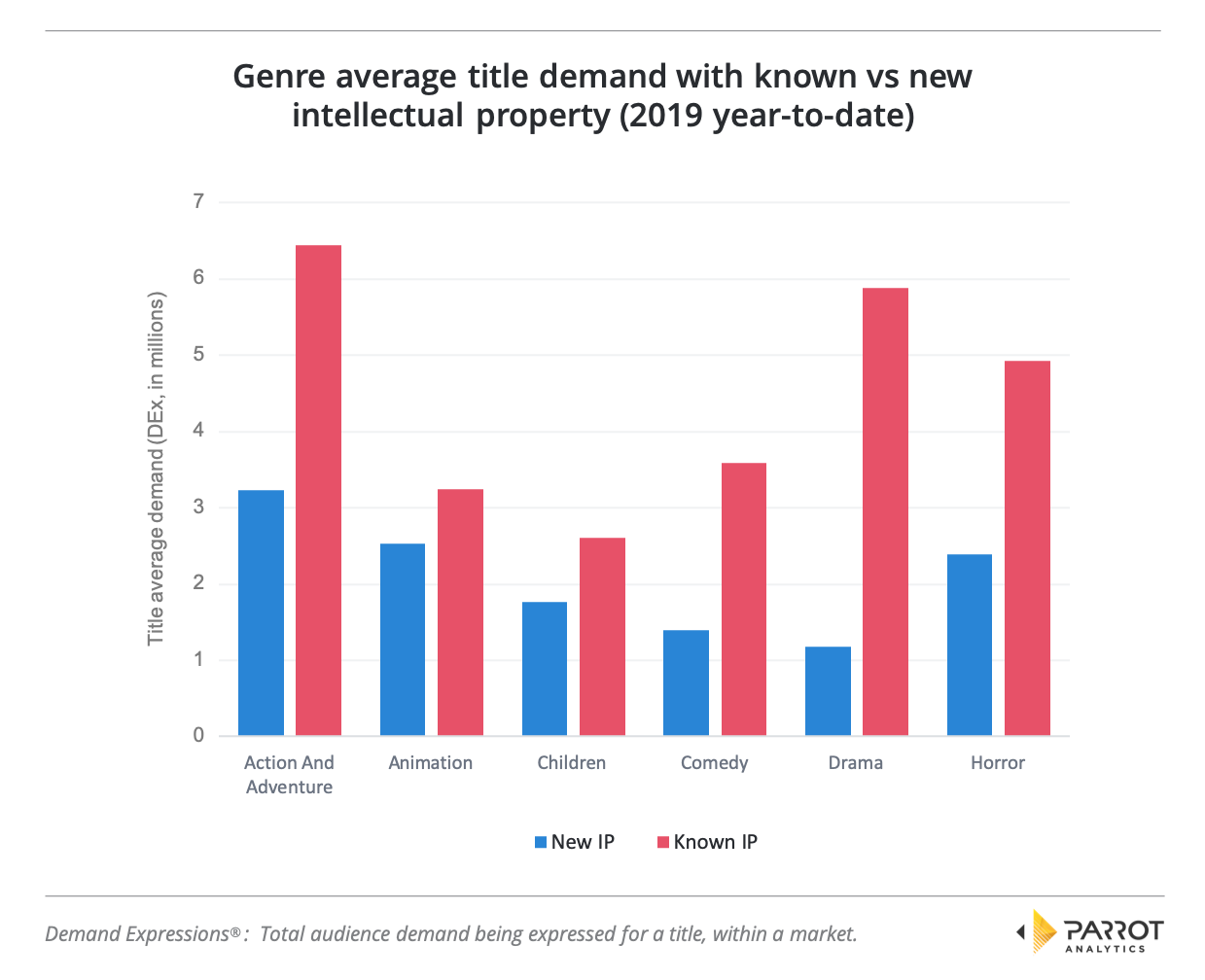
Still, known IP is more effective for dramas than any other genre in the US market: Dramas with known IP are five times more in demand than dramas with new IP. The impact of known IP thus appears to be most pronounced for highly in-demand genres with a large long tail such as drama, and to a lesser degree, comedy. Fantastic hits like The Handmaid’s Tale, one of the best series based on a book, demonstrate that digital originals with known IP could knock out the competition.
On the other hand, for white space categories with less total genre demand and fewer titles such as animation, children’s content, horror, as well as action and adventure, known IP’s impact appears to be reduced. In other words, this content may be desirable regardless of known IP.
Newcomers and early streamers alike will need to consider these factors to optimize their libraries to capture these opportunities in demand, and to use known IP to stand out amongst the long-tail of competitive titles.
SVODs with little or no IP may be persuaded to pursue animation and children’s content with a greater likelihood of success. Yet, for those platforms that wish to leverage known IP, dramas are the most strategic choice. We know that these are highly in-demand and that IP most effectively increases the perceived quality for dramas.
With all these factors considered, the genre rank order for SVODs once again changes as seen in the updated table provided below:
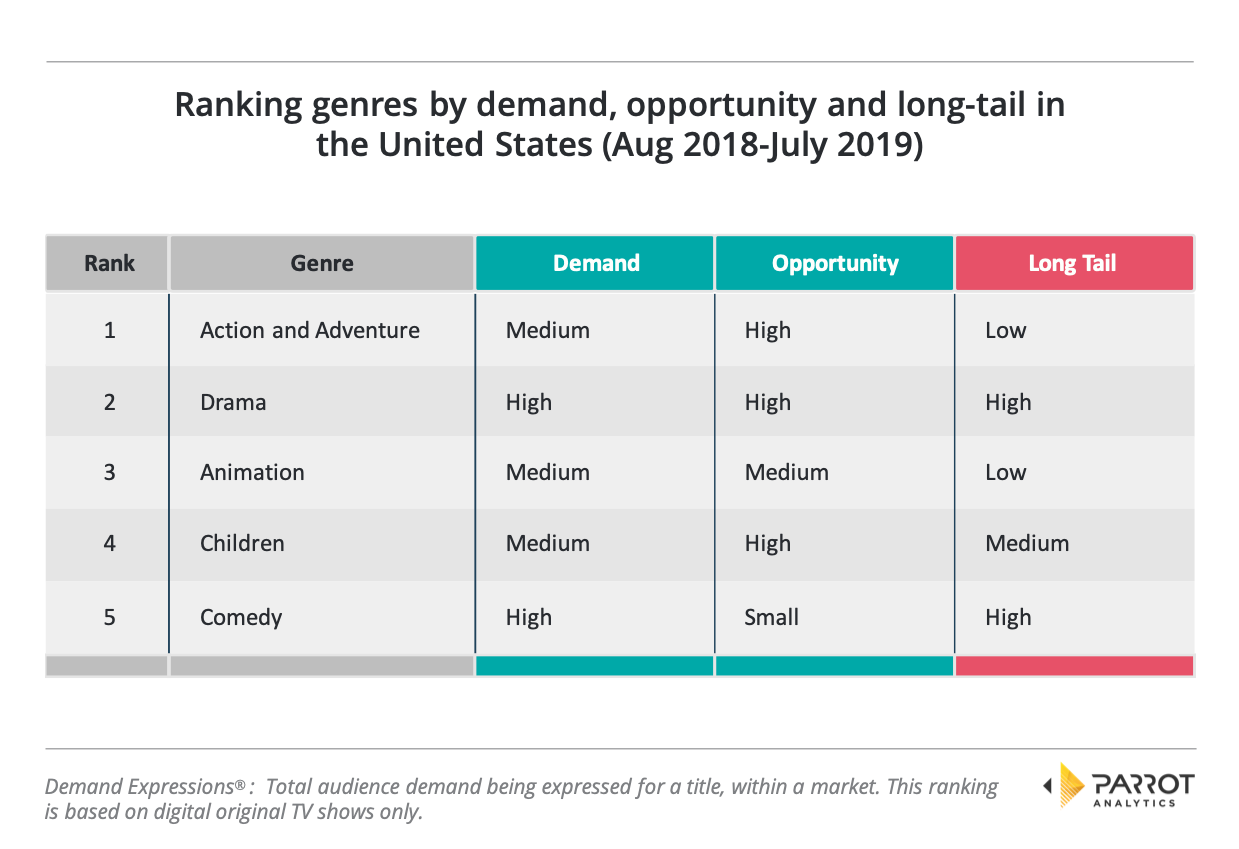
Given these rankings, let us once again return to the value drivers of digital originals: Niche or unique content. With drama in the number one spot, let us now investigate which types of dramas represent the biggest opportunity.
Investigating the drama opportunity
Using the subgenre gene from our Content Genome, we can look into the audience desire for original content one level deeper with a more granular white space analysis.
As the chart below for the US market demonstrates, we discover that crime, science fiction, family, and to some extent teen dramas offer the greatest white spaces for SVODs amongst all dramas.

Crime dramas, which have high demand but also contain a high number of titles which results in high competition, are still considered undersaturated. This is due to the relative size of total demand for this subgenre compared to the number of titles. We speculate that this subgenre may therefore be the most promising genre for a digital original with known IP.
A stand-out show in crime drama is likely going to draw subscribers. Take for instance the smashing success of Big Little Lies. In such subgenres, Disney+, HBO Max, NBCU, and Apple TV+’s originals may be able to not only fulfill these unmet audience demands, but also create chart-topping titles based on known IP.
And, it seems from the outset, that HBO Max and Disney+ may already be placing their known IP in one of these white space subgenres: Teen dramas. Variety’s columnists Elaine Low and Joe Otterson have noted the way HBOMax is buying up projects from the WarnerMedia library to create digital originals including the sequel to Gossip Girl and a prequel of Practical Magic. Meanwhile, Disney+ has announced the High School Musical: The Musical: The Series and The Lizzie McGuire revival.
Though teen dramas may not represent the largest opportunity, these productions may be an especially smart choice given the demographic of streamers tends to lean younger. We know 18-35 year-olds make up the largest population of streamers and that they are willing to subscribe to three or more streaming services, which makes them an ideal demographic to target.
Yet, it is important to note that IP is not the only path to a victory. There is an associated risk and cost of building content based on known IP such as disappointing and frustrating fans in rewriting the stories of beloved characters. Meanwhile, there are other tactics that streamers can use to leverage existing demand such as global talent demand analysis or audience affinity patterns that may be equally powerful, but these are subjects for a future article.
Calling a close match: Parrot Analytics predictions
In reviewing the evidence, we can confidently say that determining any victors is a far more nuanced endeavor than it may appear.
In fact, we are not entirely convinced calling a winner or loser is possible given the many options and opportunities that each player may capitalize upon, let alone the vastly different business models they each operate. What we do know is that each player will find it necessary to test how to best acquire, produce, curate, and promote content to find their edge as an SVOD and become a successful competitor. (And in that respect our four essential questions to ensure SVOD platform success are an important consideration).
We are rooting for each player to give audiences the best possible value. We are cheering on these new contenders in the hope for maximum experimentation based on greater problem-solving creativity, resulting in captivating story-telling and real value-for-money for consumers.
And, we have some ideas for how each player may be able to become a winner in doing so – interested? Stay tuned, because coming up next we’ll share some of our opinions and provide a personalized roadmap for navigating and winning on the battlefield – for new challengers and incumbents alike.
Image Credit: “Electronic Superhighway: Continental US, Alaska, Hawaii” by Nam June Paik (1995): 15 x 40 x 4 ft., at the Smithsonian American Art Museum.
Photo credit: centralasian/flickr.com



